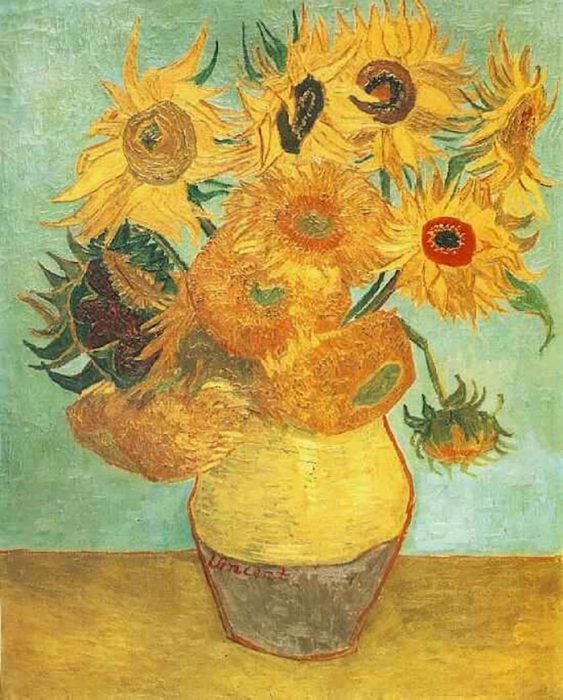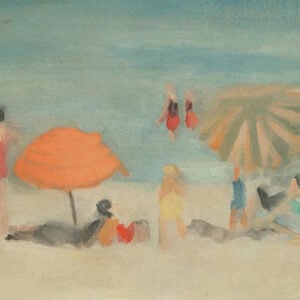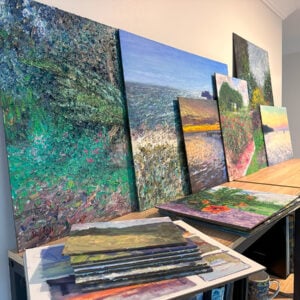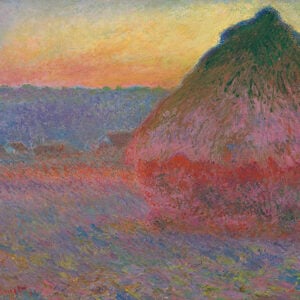In this post, I take a closer look at Vincent van Gogh’s Sunflowers series which he painted in Paris and Arles. The series highlights van Gogh’s progression in color and style. It also provides some interesting links between van Gogh and another famous artist, Paul Gauguin. In this post, I cover:
- Key Facts and Ideas
- Paris Sunflowers
- Arles Sunflowers
- Key Takeaways
- Want to Learn More?
- Thanks for Reading!

Key Facts and Ideas
Below are some of the key facts and ideas about the series:
- The series is comprised of two sets of paintings: the Paris paintings created around 1887 and the Arles paintings created around 1889. Both sets are shown later in this post.
- In my opinion, the most interesting thing about the Sunflowers series is the way it links van Gogh and Gauguin. Van Gogh had ideas of owning a studio with Gauguin, decorated with “nothing but large sunflowers”. With this in mind, he started painting the series whilst he was living with his brother Theo in Paris. Below is a great extract from one of his letters to Theo:
“I’m painting with the gusto of a Marseillais eating bouillabaisse, which won’t surprise you when it’s a question of painting large Sunflowers. I have 3 canvases on the go, 1) 3 large flowers in a green vase, light background (no. 15 canvas), 2) 3 flowers, one flower that’s gone to seed and lost its petals and a bud on a royal blue background (no. 25 canvas), 3) twelve flowers and buds in a yellow vase (no. 30 canvas). So the last one is light on light, and will be the best, I hope. I’ll probably not stop there. In the hope of living in a studio of our own with Gauguin, I’d like to do a decoration for the studio. Nothing but large Sunflowers.” Letter from Vincent van Gogh to Theo van Gogh, August 1888
- Gauguin was eventually convinced to stay with van Gogh in Arles in the “Yellow House” (depicted below). Theo helped convince Gauguin by providing him with funding. Van Gogh decorated Gauguin’s room with two paintings from the Paris set.

- Below is a painting by Gauguin that features van Gogh painting his sunflowers:

- Van Gogh had a fit of insanity in 1888, famously cutting off a piece of his ear. He also “pursued Gauguin with a knife and threatened him intensely”, according to the Van Gogh Gallery. Gauguin later departed Arles and tried to claim another painting from the Sunflowers series in return for some studies he left behind. Van Gogh was unpleased with this:
“I am definitely keeping my sunflowers in question. He has two of them already, let that hold him. And if he is not satisfied with the exchange he has made with me, he can take back his little Martinique canvas, and his self-portrait sent me from Brittany, at the same time giving me back both my portrait and the two sunflower canvases which he has taken to Paris. So if he ever broaches this subject again, I’ve told you just how matters stand.” Letter from Vincent van Gogh to Theo van Gogh, 17 January 1889
- Van Gogh mentioned on several occasions in his letters to Theo about a triptych featuring two sunflowers paintings and his Berceuse portrait, with Berceuse in the middle and the sunflowers being “the yellow wings” on the sides. Below is an extract from one of van Gogh’s letters explaining his idea, his sketch of the idea and the Berceuse portrait.
“What you also have to know is that if you arrange them this way, namely “La Berceuse” in the middle and the two canvases of sunflowers to the right and left, it makes a sort of triptych. And then the yellow and orange tones of the head will gain in brilliance by the proximity of the yellow wings.” Letter from Vincent van Gogh to Theo van Gogh 22 May 1889


- Two paintings from the series (the same two paintings mentioned in the triptych point above) were selected by van Gogh to be exhibited in Les XX, 1890. Les XX was a group of twenty Belgian creatives who held an annual, invite-only exhibition.
- The vivid yellows used throughout the series, like chrome yellow, were first manufactured early in the 19th Century. Van Gogh was one of the first artists to fully utilize these vivid yellow colors.
- In 1987, van Gogh’s Still Life: Vase with Fifteen Sunflowers was sold for $39,921,750 USD. Here is a list of the most expensive paintings ever sold.
- A painting from the series was featured in a painting by Isaac Israëls below:

Paris Sunflowers
Below are paintings that van Gogh painted in Paris. These paintings feature dramatic sunflowers resting on a surface, whilst the later Arles paintings feature bright sunflowers in a vase.

The painting below features a powerful contrast between the powerful oranges and yellows and the dull blues in the background. Also, notice how van Gogh used directional brushwork to help guide your eyes around the painting, particularly in the blue area.

In the painting below, van Gogh made interesting use of hatching to paint the surface which the flowers are resting on.

Van Gogh experimented with a very dark, green background at the top of the painting. This is in stark contrast to the bright blue and yellow backgrounds in the Arles paintings which follow.

Arles Sunflowers
The Arles series consists of four originals and three repetitions. These paintings are brighter and more typical of van Gogh’s style we have all come to know. These are also the paintings most people are referring to when they speak of the Sunflower series (the Paris paintings are often overlooked).

Van Gogh made interesting use of vivid yellows and oranges to outline the shapes in the painting below. Combined with the rich blue background, the flowers almost appear to glow.

The third version below is much more restrained, with soft yellows, blues and greens used. Notice the interesting tiling technique which van Gogh used, particularly for the wall and vase. This builds up a strong sense of texture and form in the painting.

In the painting below, van Gogh utilized a full range of yellows to depict the entire life of a sunflower: from bright yellows in full bloom to dull ochres in wilting and death. This painting also demonstrates what is possible with a very limited range of colors.

The three paintings which follow are actually repetitions of earlier versions of the Arles paintings. To me, these repetitions lack the same passion which van Gogh put into creating the originals.



Key Takeaways
Here are some of the key takeaways from the series which you can apply to your own paintings:
- Painting the same subject over and over again allows you to experiment with different colors, techniques, and styles.
- Outlining can give your paintings a strong stylistic appearance.
- The colors you use determine the overall “feeling” of your painting. For example, van Gogh’s paintings which feature a strong contrast between blue and orange (complementary colors) have a powerful and jarring feel. On the other hand, van Gogh’s paintings which feature mostly different yellow tones have a more subtle and calming feel.
- Writing can complement your art in many ways (after all, writing is just another form of art). It can help document your thoughts, explore new ideas and communicate your findings. Part of the reason van Gogh is so interesting to write about is because of his many letters to his brother and other artists which provide unique insights into his life and art.
Want to Learn More?
You might be interested in my Painting Academy course. I’ll walk you through the time-tested fundamentals of painting. It’s perfect for absolute beginner to intermediate painters.
Thanks for Reading!
I appreciate you taking the time to read this post and I hope you found it helpful. Feel free to share it with friends.
Happy painting!
Dan Scott

Draw Paint Academy







Thank you for this information. I have never seen the Paris sunflowers and the first and second versions before, let alone the copies! I actually liked the second copy of the fourth version better than the original… I have a question from a beginner :): Do artists always paint background after the main subjects? Thank you.
Thank you Dan. This was a very enlightening article to read. Vincent was a very talented artist and I appreciate his level of creativity.
As a fellow artist I am not fond of repetition. I think a painting is very personal to “the moment” of an artists expression on canvas. To each day is different and different feelings and emotions are in play and this can’t be repeated. In a way something gets “lost”. But again this is just my thoughts on trying to recapture a previous painting.
Thanks for your emails I enjoy them very much
God Bless
Again, Dan, thanks for your very interesting and timely post. I just returned from Houston Museum of Fine Art where the VanGogh exhibit is being held. The exhibit was well done. Love your post and will forward this one to my artist traveling companions.
Always interesting to read and see paintings of this colorful artist. I pass this info to my artist friends here in my village of St. Antonin Noble Val
I like some of his other works but I’ve never been sure about these sunflower paintings. They have become famous but not for their merits as paintings (in my opinion). Assume for a moment that Van Gogh had never existed and that you saw one of these paintings in a charity shop. Would you buy it?
To me, his madness shows in most of his Paris works, but at the same time, it’s more interesting. I’ve never been attracted to his paintings, other than Starry Night… This information changed that. Thank you!
To me, his madness shows in most of his Paris works, but at the same time, it’s more interesting. I’ve never been attracted to his paintings, other than Starry Night… This information changed that. Thank you!
These paintings and his fascination with sunflowers have me comparing his wild madness with the wild madness of sunflowers that he captures so vibrantly in his work. Thank you from a beginner artist.
Thank you Dan, for very detailed information about Sunflowers paintings! It’s very nice to know about Van Gogh work, his doubt , challenge and creativity. I love your post about this incredible artist!
Having just spent some time in Arles, Provence, and seen how much he is revered in the town, has renewed my interest in his work and style. Especially visiting the site of the Yellow House ,(lost in WW2), and the yellow cafe where he lived, also the Arena, where he painted the crowds, rather than the activities. Your article came at a very opportune time.
Thanks Dan…another absolutely marvelous post about a very special person.
Thank you for sharing this Dan. His letters make it so interesting, and we get to see many paintings that we wouldn’t normally see. I have followed the Van Gogh Museum on Instagram and they show many paintings that aren’t very well known, at least to me. His style and colors are fascinating.
It’s amazing,Dan!
Once again, your emails never miss informing, instructing, and encouraging artists to be themselves. You chose the best artist to show this. I was not familiar with the series of sunflowers. I found myself loving all of them, but the dark #4 the most. Have you seen the film Loving Vincent? It’s not to be missed if you admire this artist. Thank you, Dan.
Thanks for your comments Gerry! I haven’t yet, but I will look into watching it soon. Thanks. Dan
we are proud of our Vincent.
And I find his Paris flowers better then the light ones. The lighter ones are in his uniek writhing, but the colors are save. The darker once are more outspoken and fare away of the safety Arles ones.
It is pure Vincent.
He is from Brabant, and the families are mostly very connected. Hence his manny writhing to his brother.
If you know there culture you wil understand there communication.
Thank you.
Extremely helpful and very interesting. Thanks.
Thank you for the article, Dan. It’s very informative and encouraging.
My wife and I like “Vincent van Gogh, The Paris Sunflowers, 1887 (2) (4)” best of the above, and I appreciate his tiled backgrounds. Personally, however, I find Vincent Van Gogh’s paintings in general to be rather crude and immature.
I am aware the Post-Impressionist period was focused on “reverse engineering” artists’ impressions of what they observed: “Post-Impressionists extended Impressionism while rejecting its limitations: they continued using vivid colours, often thick application of paint, and real-life subject matter, but were more inclined to emphasize geometric forms, distort form for expressive effect, and use unnatural or arbitrary colour” (Post-Impressionism, https://en.wikipedia.org/wiki/Post-Impressionism).
However, with his added twist, “Van Gogh was an admirer of the Realism of Jules Breton, Gustave Courbet and Millet,[165] and he compared his copies to a musician’s interpreting Beethoven.[166]” [Vincent van Gogh, Saint-Rémy (May 1889 – May 1890), https://en.wikipedia.org/wiki/Vincent_van_Gogh%5D.
Nonetheless, I think that if Van Gogh could become famous for his less refined painting style, then almost everyone has a chance at fame. So, there’s hope for us all.